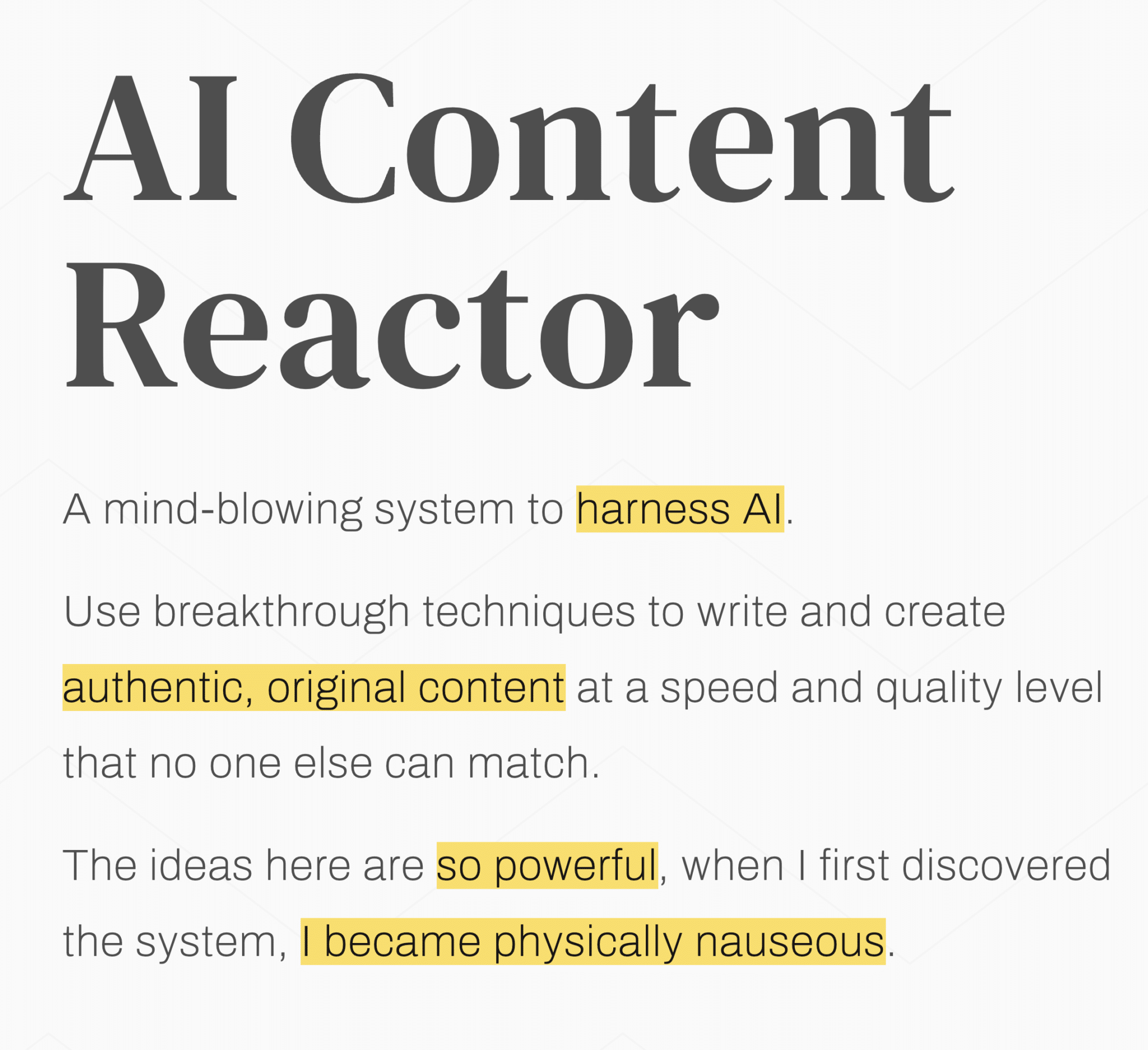At the heart of Level343 is a team of optimizers, marketers, content developers, and copywriters. We talk a lot about optimization, marketing strategies, and content development, but copywriting strategies have been, we must confess, kind of the red-headed stepchild. However, without strong copywriting strategies, the other three wouldn’t work near as well.
Content development focuses on in-depth, often long-form content. Copywriting, on the other hand, focuses on persuasive, concise text. While they complement each other, they aren’t the same.
In this article, we’ll talk about the difference between content development and copywriting strategies. We’ll share a few content development strategies and copywriting best practices, and then finish with showing you how to incorporate it all into powerful content that converts.
If you’re part of a marketing team, a content strategist, a new copywriter, or a small business owner, this article is for you.
Let’s go!
Table of contents
Content development and copywriting compliment each other, but aren’t the same.
“Connect in a meaningful way,” says the marketer. But what does that mean? How do you do that? The answer are two similar disciplines the support each other: content development and copywriting.
What is content development?
Briefly, content development is a process of planning, creating, and managing in-depth marketing materials (AKA pieces of content). This content can include blog posts, videos, podcasts, white papers, and ebooks, among others. The primary purpose of content development is to educate, inform, and build relationships with your audience.
Key Characteristics:
- Content development focuses on pieces that are in-depth and long form. These pieces provide extensive information and are often narrative or analytical form.
- Content development is SEO and engagement-centric. It often prioritizes search optimization, user engagement, and building authority over time.
- Content development looks at multi-channel distribution. From blogs to social media platforms, content development makes sure the message stays consistent across touchpoints.
HubSpot’s resource library is a classic example of effective content development. Their in-depth guides have helped the brand establish themselves as an industry authority.
What is copywriting?
If content development is a discipline, copywriting is an art. Copywriters create concise, persuasive content that is meant to entice the reader to take a specific action. Every word is carefully chosen to encourage conversion, whether you want your audience to purchase something, sign up for a newsletter, or click a call-to-action.
- Copywriting has tight, energetic, persuasive language. The goal is to spark an immediate emotional response.
- Copywriting uses direct calls-to-action and (often) benefits-focused messaging to drive user behavior.
- Copywriting is often involved in A/B split testing and tweaking to maximize your conversion rates.
Consider Nike’s “Just Do It” campaign. The slogan is powerful and succinct. Who knew you could do so much with three words that aren’t “I love you”? With Nike’s three words, they motivate their audience by blending emotional appeal with a straightforward call-to-action.
The basics of copywriting and content development are the same.
In both, you have to know your audience to connect with your audience. You need to know who your ideal customer is and what their pain points are.
What is your message?
Precisely understanding the message you need to convey is your first consideration when starting a new copywriting project. Whether you are selling a product or service or promoting an idea, the concept and how you want it to come across should be crystal clear in your mind before you begin writing.
This means having a clear understanding of what you want to say and what you want your readers to do. Once you know your message, you can develop headlines and copy that effectively communicate your ideas.
Who is your target audience?
It’s not enough just to have a great message – you also need to define your target audience. Who are you trying to reach? What are their needs and wants? What will resonate with them? Keep these things in mind as you develop your content so that you can create materials that truly speak to your readers.
Your specific audience is your second consideration when crafting successful copy. It’s important to understand who your potential customers are and what they’re looking for. Developing buyer personas can be helpful in this regard. For example, you would write differently for children versus senior citizens or young adult students, and your writing style should be customized to the product or message that is being conveyed.
Just as you would adjust your verbal conversation depending on who you are talking with, the same goes for copywriting. Tailor the style of language to target your audience and to have the greatest impact. It helps your writing process to know the needs and wants of your audience or target demographic, as well as issues that are relevant to that group.
What is your lead in?
Once you know what you want to say and who you want to say it to, it’s time to start writing. And the best way to start is with a strong lead. A strong lead immediately grabs attention and sets the tone for the rest of the piece. It should be interesting, compelling, and relevant to your reader. So take some time to craft a great opening for your next piece of copywriting – it could make all the difference in good copy versus great copy!
Craft a snappy headline. Hook the reader from the start with powerful copy that resonates and doesn’t come across as routine or boring. The headline is the first element of your copy that will attract attention, so keep it interesting and be sure to include a verb to make it more descriptive and compelling.
This golden rule of journalism applies to copywriting as well. Just as the headline invites readers to click on the article, the first couple of sentences should engage readers to stay and finish the article. A boring first sentence will push the reader to click off the page and go somewhere else. Think of the lead as your pitch – you have just a few words and a small amount of space in which to interest the reader and ‘sell’ him or her on why to continue reading and consider the ideas you have shared.
Craft each sentence with the purpose of supporting your main argument or call to action, using persuasive language to enhance your chance of influencing the reader. By adhering to these strategies, your copy will not only be clear and direct but also more likely to persuade effectively.
Copywriting takes content development up a notch.
While content development forms the backbone of your marketing efforts, copywriting transforms that well-crafted information into a compelleing narrative that inspires action. With copywriting, strategy meets creativity and every word is an opportunity to connect, persuade, and convert.
In essence:
- Content development lays the groundwork by informing and engaging.
- Copywriting seals the deal by converting that engagement into tangible outcomes.
Marketing campaigns that artfully blend the two provide much more bang for your marketing efforts. By understanding and using both disciplines appropriately, your brand can craft a well-rounded marketing strategy that not only draws in an audience but also compels them to act.
Leave the reader with a takeaway.
Even a short piece of copywriting should progress in narrative form with a beginning, middle and end, leaving the reader with a clear and cohesive idea of what was just presented. The narrative should conclude with a takeaway concept that is intriguing enough to stay on the brain after the reader moves on to another page or activity. Even if the body of the copy is not wholly unique (it’s been written before) – a quirky angle or insight can make your article resonate.
Craft strategies for compelling copywriting.
Write content that attracts attention and motivates readers to repost and promote your work. The more interesting and unique your content, the more credibility it will gain and the greater exposure your writing will develop over time. To keep it real, add a fresh angle, a little-known fact, a current statistic or an emotional appeal to pique interest.
Tap into basic emotions.
Writing that awakens emotions, either positive or negative, is almost guaranteed to keep people reading. Be provocative. Raise questions. Share facts that are astonishing. Present a delicate situation or ask the reader to solve a riddle. In effect, your copy should urge the reader to think a certain way.
Get to the point.
With information overload being the norm, brevity is crucial. Follow the advice of the renowned grammarians William Strunk, Jr. and E. B. White, “Omit needless words.” Prioritize clarity and brevity. Focus on strong, active verbs to drive your points home and break complex ideas into digestible bullet points or subheadings.
Be credible.
Trust is key. Presenting facts accurately ensures trust and authority in your voice. When offering opinions or creative ideas, they must stand on a foundation of plausibility—even if set in a fantastical realm.
Much like the way science fiction and fantasy genres captivate their audiences by weaving imaginative yet coherent worlds, effective copywriting strategies should blend creativity with credibility. This approach not only respects the intelligence of your readers but also enhances the overall impact of your message, making it both engaging and trustworthy.
Create a sense of urgency.
A strong call-to-action is just as essential as trust. What do you want the reader to do after they finish reading your piece? Whether it’s signing up for a newsletter, downloading a white paper, or making a purchase, be sure to include a clear, concise CTA.
Develop a habit of continual testing.
You want to make sure your copy is always hitting the mark, and you do that by integrating continual testing into your creative process. Experiment with:
- narrative structures
- content formats
- design elements
- headlines
- CTAs
Use A/B testing tools and gather user feedback to identify which variations resonate best with your audience. Over time, this iterative process refines your strategy, leading to higher engagement and improved conversion rates.
Build up your storytelling techniques
Storytelling is the heart of both compelling content development and persuasive copywriting. A well-crafted narrative not only informs but also inspires and emotionally connects with your audience. In this section, we explore techniques to enhance your storytelling:
- Personalization: Tailor your stories to mirror your audience’s experiences. By customizing your narrative, you create a deeper, more authentic connection.
- Clear Structure: Use traditional story arcs—beginning, middle, and end—to ensure your narrative flows logically and keeps your readers engaged.
- Visual Imagery: Incorporate vivid descriptions and support your words with relevant visuals or graphics. This helps paint a mental picture that enhances your message.
- Authenticity: Include real-life examples or personal anecdotes to build trust and credibility. Authentic stories resonate more powerfully than abstract concepts.
- Suspense and Curiosity: Introduce elements that create intrigue—pose questions, add a twist, or leave a thread to be tied up later. This keeps your readers hooked until the very end.
By honing your storytelling techniques, you not only add depth to your copy but also transform your content into memorable experiences that drive your audience to act.
Wrapping it up
Mastering copywriting isn’t a one-time achievement, it’s an evolving journey. It turns your marketing campaigns into relentless conversion engines that build trust and drive tangible results. Now it’s time to put these strategies into action: experiment boldly, refine relentlessly, and watch your words work wonders.
Are your copywriting skills less than satisfactory? With over two decades of marketing acumen, we know what it takes to make your content go to work for you. Contact Level343 for experienced copywriters that can take your website content up to the next level.



































